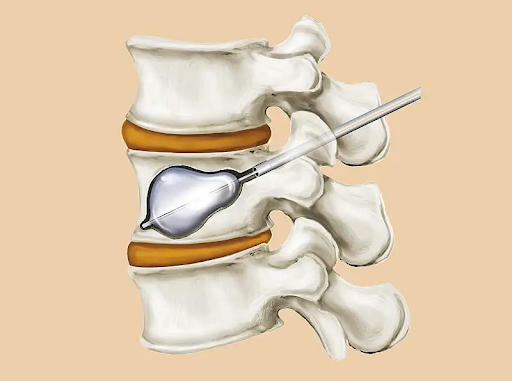
Balloon Kyphoplasty is a procedure that stabilizes a fractured vertebra. This reduces back pain and aligns the spine. A compression fracture is when the usual rectangular shape of a bone becomes compressed and starts to cause back pain.
Many have found the procedure successful, and they can walk without help, the functioning of the back improves, and it increases the quality of life.
It is important to understand what is being done on your body to be aware of any side effects to remain peaceful throughout the process. It enables you to understand the side effects, the medication used, and the care required after the procedure.
- Space is first created for the balloon into the fractured bone by hollow equipment. The balloon is guided through the equipment into the bone.
- The balloon is now inflatedto raise the collapsed one to its normal position.
- Once it is confirmed that the bone is in the correct position, the balloon is then deflated, leaving a void within the vertebral body.
- The void has to be filled to avoid another compression fracture. Orthopedic cement is usually used to fill the void.
- The cement then forms a cast that stabilizes the bone that it cannot collapse.
The Balloon Kyphoplasty is a process that does not takemuch time. Most patients get discharged within a day of when they underwent surgery. It is essential to consult your doctor just in case you think this could be the solution.
The process has been recommended by many due to several reasons:
You can now resume to your day to day activities as soon after the surgery.
You can no longer get stress on many nights in the hospital as you can be discharged on the same day of surgery.
The procedure can be carried out using local anesthesia. This, however, depends on a patient’s general health and the condition of the spine. He/ she can use general anesthesia.
The procedure can be carried out in hospitals, outpatient spine surgery center, or in an ambulance surgery center.
You can sort your back pain within a short period.
Post-procedure care is also essential. Doctors encourage patients to walk around, although they may experience some soreness. This is normal, though it gets better within 48 hours after the procedure.
In case your general health is not that good, it could be better to remain in the hospital for a while for supervision.
Avoid lifting heavy things after surgery; this includes carrying the baby. Ample rest is crucial for a quicker recovery.
There may be medications or supplements administered to strengthen the bones.
Several complications could come up. Needles usually cause bleeding and infections because of the penetration in the skin. Nerve damage can cause numbness or weakness. An allergic reaction can also occur.
It’s great to be hopeful and consider yourself among the larger number that benefits from the procedure.
The procedure is more successful when if undertaken within two months of a compression fracture diagnosis.